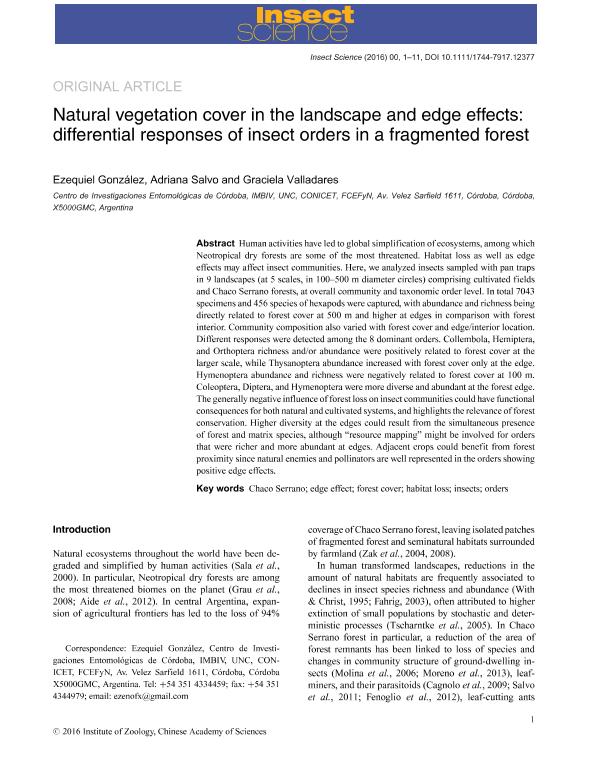Mostrar el registro sencillo del ítem
dc.contributor.author
González, Ezequiel

dc.contributor.author
Salvo, Silvia Adriana

dc.contributor.author
Valladares, Graciela Rosa

dc.date.available
2017-09-07T14:24:15Z
dc.date.issued
2016-09-20
dc.identifier.citation
González, Ezequiel; Salvo, Silvia Adriana; Valladares, Graciela Rosa; Natural vegetation cover in the landscape and edge effects: Differential responses of insect orders in a fragmented forest; Wiley Blackwell Publishing, Inc; Insect Science; 20-9-2016; 1-11
dc.identifier.issn
1672-9609
dc.identifier.uri
http://hdl.handle.net/11336/23756
dc.description.abstract
Human activities have led to global simplification of ecosystems, among which Neotropical dry forests are some of the most threatened. Habitat loss as well as edge effects may affect insect communities. Here, we analyzed insects sampled with pan traps in nine landscapes (at five scales, in 100 - 500m diameter circles) comprising cultivated fields and Chaco Serrano forests, at overall community and taxonomic order level. In total 7,043 specimens and 456 species of hexapods were captured, with abundance and richness being directly related to forest cover at 500m and higher at edges in comparison with forest interior. Community composition also varied with forest cover and edge/interior location. Different responses were detected among the eight dominant orders. Collembola, Hemiptera and Orthoptera richness and/or abundance were positively related to forest cover at the larger scale, while Thysanoptera abundance increased with forest cover only at the edge. Hymenoptera abundance and richness were negatively related to forest cover at 100m. Coleoptera, Diptera and Hymenoptera were more diverse and abundant at the forest edge. The generally negative influence of forest loss on insect communities could have functional consequences for both natural and cultivated systems, and highlights the relevance of forest conservation. Higher diversity at the edges could result from the simultaneous presence of forest and matrix species, although "resource mapping" might be involved for orders that were richer and more abundant at edges. Adjacent crops could benefit from forest proximity since natural enemies and pollinators are well represented in the orders showing positive edge effects.
dc.format
application/pdf
dc.language.iso
eng
dc.publisher
Wiley Blackwell Publishing, Inc

dc.rights
info:eu-repo/semantics/openAccess
dc.rights.uri
https://creativecommons.org/licenses/by-nc-sa/2.5/ar/
dc.subject
Chaco Serrano
dc.subject
Edge Effect
dc.subject
Forest Cover
dc.subject
Habitat Loss
dc.subject
Insects
dc.subject
Orders
dc.subject.classification
Bioquímica y Biología Molecular

dc.subject.classification
Ciencias Biológicas

dc.subject.classification
CIENCIAS NATURALES Y EXACTAS

dc.title
Natural vegetation cover in the landscape and edge effects: Differential responses of insect orders in a fragmented forest
dc.type
info:eu-repo/semantics/article
dc.type
info:ar-repo/semantics/artículo
dc.type
info:eu-repo/semantics/publishedVersion
dc.date.updated
2017-08-29T17:30:21Z
dc.identifier.eissn
1744-7917
dc.journal.pagination
1-11
dc.journal.pais
Reino Unido

dc.journal.ciudad
Londres
dc.description.fil
Fil: González, Ezequiel. Consejo Nacional de Investigaciones Científicas y Técnicas. Centro Científico Tecnológico Conicet - Córdoba. Instituto Multidisciplinario de Biología Vegetal. Universidad Nacional de Córdoba. Facultad de Ciencias Exactas Físicas y Naturales. Instituto Multidisciplinario de Biología Vegetal; Argentina
dc.description.fil
Fil: Salvo, Silvia Adriana. Consejo Nacional de Investigaciones Científicas y Técnicas. Centro Científico Tecnológico Conicet - Córdoba. Instituto Multidisciplinario de Biología Vegetal. Universidad Nacional de Córdoba. Facultad de Ciencias Exactas Físicas y Naturales. Instituto Multidisciplinario de Biología Vegetal; Argentina
dc.description.fil
Fil: Valladares, Graciela Rosa. Consejo Nacional de Investigaciones Científicas y Técnicas. Centro Científico Tecnológico Conicet - Córdoba. Instituto Multidisciplinario de Biología Vegetal. Universidad Nacional de Córdoba. Facultad de Ciencias Exactas Físicas y Naturales. Instituto Multidisciplinario de Biología Vegetal; Argentina
dc.journal.title
Insect Science

dc.relation.alternativeid
info:eu-repo/semantics/altIdentifier/url/http://onlinelibrary.wiley.com/doi/10.1111/1744-7917.12377
dc.relation.alternativeid
info:eu-repo/semantics/altIdentifier/doi/http://dx.doi.org/10.1111/1744-7917.12377
Archivos asociados
